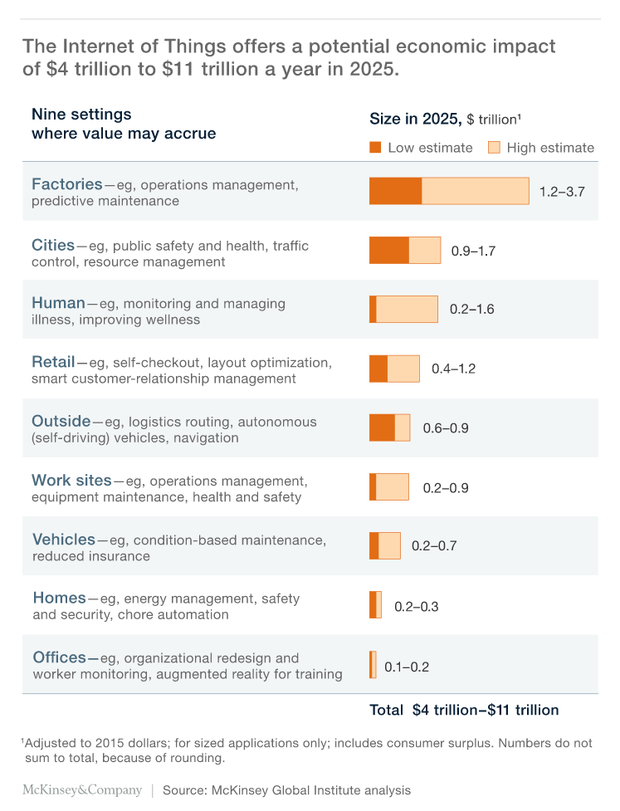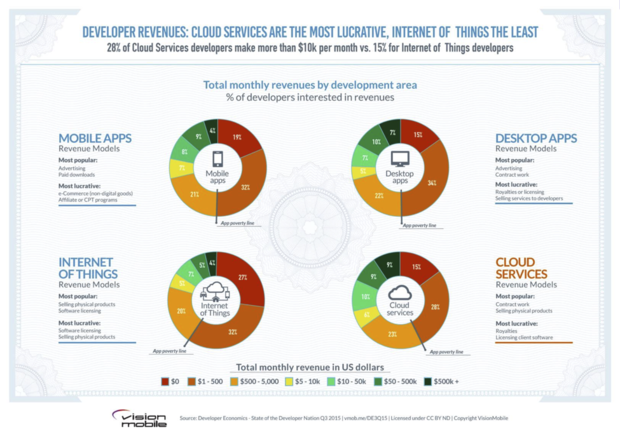infoworld.com

Purportedly, the market opportunity for the Internet of things is gargantuan -- but development in the space clearly isn't paying off yet
The
Internet of things may be hot, hot, hot, according to the Valley, but it’s not
paying the bills. In fact, less than 10 percent of IoT developers are making
enough to support a reasonably sized team.
That’s one
key takeaway from the latest VisionMobile Developer Economics report, released
this week. It’s a sobering thought for the companies jumping into IoT as they
chase IoT’s purported $11 trillion jackpot.
As with
every other business, the only way companies will realize this value in terms
of revenue will be to attack the IoT market with a clear idea of what they’re
selling and to whom.
A big
market, but underserved
In its
“Unlocking the potential of the Internet of Things” report, McKinsey & Co.
highlights nine areas where IoT will unlock value:

Unfortunately,
much of that value never gets realized, both because a dearth of IoT standards
has logjammed its potential and because most IoT data simply isn’t used.
As the
McKinsey report concludes, “Currently, most IoT data are not used. For example,
on an oil rig that has 30,000 sensors, only 1 percent of the data are examined.
That’s because this information is used mostly to detect and control anomalies
-- not for optimization and prediction, which provide the greatest value.”
In other
words, that oil rig may derive value from its current use of IoT data, but the
vast majority of potential value remains unexplored.
This may
not be the IoT customer’s fault. As the Developer Economics survey data
suggests, it could be that IoT vendors still aren’t sure of what they’re
peddling -- or rather, to whom.
IoT sells,
but who is buying?
A full 59
percent of IoT-focused developers can’t scrape together $500 per month, putting
them below the “poverty line” established by VisionMobile. If we set the bar at
$5,000 per month, 79 percent of IoT developers fall short.
Indeed, of
the four areas tracked by the Developer Economics survey, which tracks revenue
and other things for 13,000 developers, IoT comes in dead last in terms of
current market opportunity:

Part of the
problem is that these IoT developers don’t know who they're developing for.
According to the report, “more than a quarter are still not sure who their
eventual customer will be.” Another third is focused on consumers, but may find
itself grasping for other straws as consumers prove a difficult market to
crack.
IoT
developers, in other words, are guessing.
They
probably need to do more guessing about enterprise applications of IoT.
McKinsey posits that 70 percent of IoT value will be found in
business-to-business scenarios -- and that may be low. While a horde of
developers is gravitating to wearables (like these Indiegogo wannabes),
“boring” applications like tractor sensors will drive far more value, not to
mention developer revenue.
Developers, and the companies that employ them, would do well
to follow the advice of Mike Olson, chief strategy officer and co-founder of
Cloudera. As Olson told me in an interview:
It's important when you start thinking about IoT to think
about why it matters. What are the business problems you want to solve, what
are the optimizations you want to make? And then design your systems to address
these problems.
[We can get caught up in] the "shiny object
syndrome" of engineers who want to play with new technology. But those
projects generally fail because they don't have clear success criteria.
For far too many companies, IoT remains a science project.
This reveals itself in how they’re funding their IoT initiatives and what
they’re building. For example, many developers are taking to crowdfunding sites
like Indiegogo to bankroll the next big wearable, not taking into account the
difficulty of subsisting on low margins at almost universally low volumes.
Others are trying to sell IoT-related software but, as
VisionMobile notes, “The market is not yet mature and too many people are
building generic solutions to device connectivity and management problems.”
But to tap
IoT's $11 trillion potential, developers need to get real about what they’re
selling and to whom. That probably involves a “dull” enterprise-facing business
-- not to mention a lot more planning than we’re currently seeing.
No comments:
Post a Comment